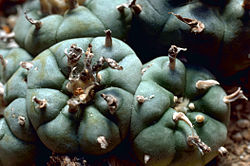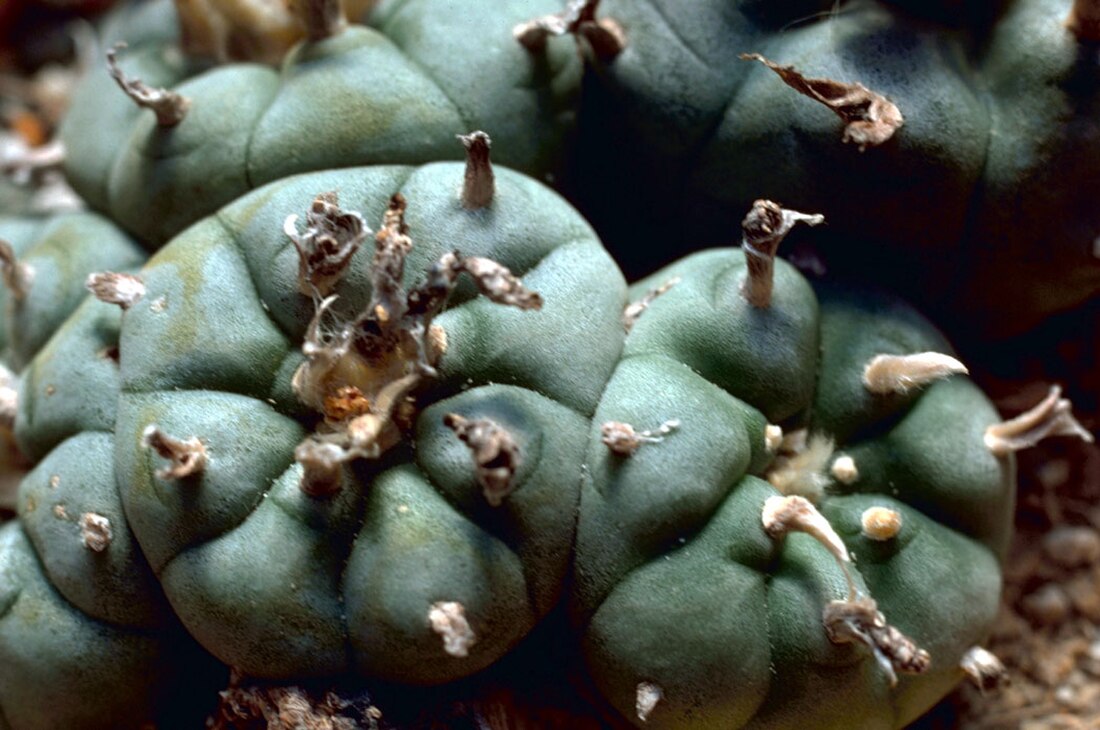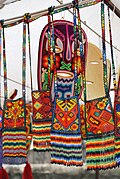Peyote
Species of psychoactive cactus From Wikipedia, the free encyclopedia
The peyote (/peɪˈoʊti/; Lophophora williamsii /ləˈfɒfərə wɪliˈæmziaɪ/) is a small, spineless cactus which contains psychoactive alkaloids,[2] particularly mescaline (see also: cactus alkaloids).[3] Peyote is a Spanish word derived from the Nahuatl peyōtl ([ˈpejoːt͡ɬ]), meaning "caterpillar cocoon", from a root peyōni, "to glisten".[4][5][6] Peyote is native to Mexico and southwestern Texas. It is found primarily in the Sierra Madre Occidental, the Chihuahuan Desert and in the states of Nayarit, Coahuila, Nuevo León, Tamaulipas, and San Luis Potosí among scrub. It flowers from March to May, and sometimes as late as September. The flowers are pink, with thigmotactic anthers (like Opuntia).
| Peyote | |
|---|---|
 | |
| Peyote in the wild | |
| Scientific classification | |
| Kingdom: | Plantae |
| Clade: | Tracheophytes |
| Clade: | Angiosperms |
| Clade: | Eudicots |
| Order: | Caryophyllales |
| Family: | Cactaceae |
| Subfamily: | Cactoideae |
| Genus: | Lophophora |
| Species: | L. williamsii |
| Binomial name | |
| Lophophora williamsii (Lem. ex J.F.Cels) J.M.Coult. | |
| Synonyms | |
|
Echinocactus williamsii Lemaire ex Salm-Dyck | |
Known for its psychoactive properties when ingested, peyote has at least 5,500 years of entheogenic and medicinal use by indigenous North Americans.[7]
Description
Summarize
Perspective
This section needs additional citations for verification. (July 2019) |


The various species of the genus Lophophora grow low to the ground and they often form groups with numerous, crowded shoots. The blue-green, yellow-green or sometimes reddish-green shoots are mostly flattened spheres with sunken shoot tips. They can reach heights of 2 to 7 centimeters (0.79 to 2.76 in) and diameters of 4 to 12 cm (1.6 to 4.7 in). There are often significant, vertical ribs consisting of low and rounded or hump-like bumps. From the cusp areoles arises a tuft of soft, yellowish or whitish woolly hairs. Spines are absent. Flowers are pink or white to slightly yellowish, sometimes reddish. They open during the day, are from 1 to 2.4 cm (0.39 to 0.94 in) long, and reach a diameter from 1 to 2.2 cm (0.39 to 0.87 in).

The cactus produces flowers sporadically; these are followed by small edible pink fruit. The club-shaped to elongated, fleshy fruits are bare and more or less rosy colored. At maturity, they are brownish-white and dry. The fruits do not burst open on their own and they are between 1.5 to 2 cm (0.59 to 0.79 in) long. They contain black, pear-shaped seeds that are 1 to 1.5 mm long and 1 mm wide. The seeds require hot and humid conditions to germinate. Peyote contains a large spectrum of phenethylamine alkaloids.[2] The principal one is mescaline for which the content of Lophophora williamsii is about 0.4% fresh (undried) and 3–6% dried.[8]
Taxonomy
French botanist Charles Antoine Lemaire described the species as Echinocactus williamsii in 1845. It was placed in the new genus Lophophora in 1894 by American botanist John Merle Coulter.
Distribution and habitat

L. williamsii is native to southern North America, mainly distributed in Mexico. In the United States, it grows in Southern Texas. In Mexico, it grows in the states of Chihuahua, Coahuila, Nuevo León, and Tamaulipas in the north to San Luis Potosi and Zacatecas.[9][10][11] It is primarily found at elevations of 100 to 1,500 m (330 to 4,920 ft) and exceptionally up to 1,900 m (6,200 ft) in the Chihuahuan desert, but is also present in the milder climate of Tamaulipas. Its habitat is primarily in desert scrub, particularly thorn scrub in Tamaulipas. It is common on or near limestone hills.[12]
Cultivation
Peyote is extremely slow growing. Cultivated specimens grow considerably faster, sometimes taking less than three years to go from seedling to mature flowering adult. More rapid growth can be achieved by grafting peyote onto mature San Pedro root stock. The top of the above-ground part of the cactus, the crown, consists of disc-shaped buttons. These are cut above the roots and sometimes dried. When done properly, the top of the root forms a callus and the root does not rot. When poor harvesting techniques are used, however, the entire plant dies.[13] Currently in South Texas, peyote grows naturally but has been over-harvested, to the point that the state has listed it as an endangered species.[14] Cultivation is an important conservation tool for this particular species.[15] Promoting San Pedro as a Peyote substitute may act as an intervention to reduce Peyote consumption.[16]
Uses
Summarize
Perspective
Psychoactivity and folk medicine

When used for its psychoactive properties, common doses for pure mescaline range from roughly 200 to 400 mg. This translates to a dose of roughly 10 to 20 g of dried peyote buttons of average potency; however, potency varies considerably between samples, making it difficult to measure doses accurately without first extracting the mescaline. The concentration of mescaline is typically highest at the sides of the peyote button.[17] The effects last about 10 to 12 hours.[18] Peyote is reported to trigger rich visual or auditory effects (see synesthesia) and spiritual or philosophical insights.[19][20]
In addition to psychoactive use, some Native American tribes use the plant in folk medicine. They employ peyote for varied ailments.[21] Although uncommon, use of peyote and mescaline has been associated with poisoning.[22] Peyote contains the alkaloid, hordenine (also called peyocactin).[23]

History
In 2005, researchers used radiocarbon dating and alkaloid analysis to study two specimens of peyote buttons found in archaeological digs from a site called Shumla Cave No. 5 on the Rio Grande in Texas. The results dated the specimens to between 3780 and 3660 BCE. Alkaloid extraction yielded approximately 2% of the alkaloids including mescaline in both samples. This indicates that native North Americans were likely to have used peyote since at least 5500 years ago.[24]
Specimens from a burial cave in west central Coahuila, Mexico have been similarly analyzed and dated to 810 to 1070 CE.[25]

From earliest recorded time, peyote has been used by indigenous peoples, such as the Huichol[26] of northern Mexico and by various Native American tribes, native to or relocated to the Southern Plains states of present-day Oklahoma and Texas. Its usage was also recorded among various Southwestern Athabaskan-language tribal groups. The Tonkawa, the Mescalero, and Lipan Apache were the source or first practitioners of peyote religion in the regions north of present-day Mexico.[27] They were also the principal group to introduce peyote to newly arrived migrants, such as the Comanche and Kiowa from the Northern Plains. The religious, ceremonial, and healing uses of peyote may date back over 2000 years.[28]
Under the auspices of what came to be known as the Native American Church, in the 19th century, American Indians in more widespread regions to the north began to use peyote in religious practices, as part of a revival of native spirituality. Its members refer to peyote as "the sacred medicine", and use it to combat spiritual, physical, and other social ills. Concerned about the drug's psychoactive effects, between the 1880s and 1930s, U.S. authorities attempted to ban Native American religious rituals involving peyote, including the Ghost Dance. Today the Native American Church is one among several religious organizations to use peyote as part of its religious practice. Some users claim the drug connects them to God.[29]
Traditional Navajo belief or ceremonial practice did not mention the use of peyote before its introduction by the neighboring Utes. The Navajo Nation now has the most members of the Native American Church.[citation needed]
Since 1846, the official Mexican Pharmacopoeia recommended the use of peyote extract in “microdose” as a tonic for the heart.[30]
John Raleigh Briggs (1851–1907) was the first to draw scientific attention of the Western scientific world to peyote.[31] Louis Lewin described Anhalonium lewinii in 1888.[32] British sexologist Havelock Ellis self experimented with it on Good Friday 1896, publishing details in 1898.[33] Arthur Heffter conducted self experiments on its effects in 1897.[34] Similarly, Norwegian ethnographer Carl Sofus Lumholtz[35] studied and wrote about the use of peyote among the Indians of Mexico. Lumholtz also reported that, lacking other intoxicants, Texas Rangers captured by Union forces during the American Civil War soaked peyote buttons in water and became "intoxicated with the liquid".[36]
Adverse reactions
A study published in 2007 found no evidence of long-term cognitive problems related to peyote use in Native American Church ceremonies, but researchers stressed their results may not apply to those who use peyote in other contexts.[37] A four-year large-scale study of Navajo who regularly ingested peyote found only one case where peyote was associated with a psychotic break in an otherwise healthy person; other psychotic episodes were attributed to peyote use in conjunction with pre-existing substance abuse or mental health problems.[38] Later research found that those with pre-existing mental health issues are more likely to have adverse reactions to peyote.[39] Peyote use does not appear to be associated with hallucinogen persisting perception disorder (a.k.a. "flashbacks") after religious use.[40] Peyote also does not seem to be associated with physical dependence, but some users may experience psychological dependence.[41]
Peyote can have strong emetic effects, and one death has been attributed to esophageal bleeding caused by vomiting after peyote ingestion in a Native American patient with a history of alcohol abuse.[42] Peyote is also known to cause potentially serious variations in heart rate, blood pressure, breathing, and pupillary dilation.[43][22]
Research into the Huichol natives of central-western Mexico, who have taken peyote regularly for an estimated 1,500 years or more, found no evidence of chromosome damage in either men or women.[44]
According to a statement made by Gertrude Bonnin in 1916, a member of the Sioux tribe, the use of Peyote had been the direct cause of death among 25 Utes in last two years.[45]
Cultural significance
Wixarika (Huichol) culture
The Wixarika religion consists of four principal deities: Corn, Kayumarie (Blue Deer), Hikuri (Peyote), and the Eagle, all descended from their Sun God. Schaefer has interpreted this to mean that peyote is the soul of their religious culture and a visionary sacrament that opens a pathway to the other deities.[46]
- Huichol art
Religion
Native American Church
Peyote is considered sacramental and sacred in the Native American Church, also known as Peyotism. It is used in rituals for "a closer understanding of the spiritual world"[47] and to commune with God and the spirits (including the deceased) in order to receive spiritual power, guidance, reproof, and healing. To many followers, peyote itself is personified as "Peyote Spirit", considered to be either God's equivalent for the Indians to Jesus for mainstream Christians, or Jesus himself.[48]
Peyote is consumed during an all-night healing ceremony inside a hogan, a traditional Navajo building, or a tipi. The ritual starts around 8 P.M Saturday, and includes prayer, singing, sacramental eating of peyote, water rites, and contemplation. It concludes with a communion breakfast on Sunday morning.[48]
Legality
Summarize
Perspective
United Nations
Canada
Mescaline is listed as a Schedule III controlled substance under the Canadian Controlled Drugs and Substances Act, but peyote is specifically exempt.[49] Possession and use of peyote plants is legal.[50]
United States
Non-drug uses of peyote in religious ceremonies by the Native American Church and its members is exempt from registration.[51] This law has been codified as a statute in the American Indian Religious Freedom Act of 1978, and made part of the common law in Peyote Way Church of God, Inc. v. Thornburgh, (5th Cir. 1991);[52] it is also in administrative law at the 21 CFR 1307.31 which states for "Special Exempt Persons":
Section 1307.31 Native American Church. The listing of peyote as a controlled substance in Schedule I does not apply to the nondrug use of peyote in bona fide religious ceremonies of the Native American Church, and members of the Native American Church so using peyote are exempt from registration. Any person who manufactures peyote for or distributes peyote to the Native American Church, however, is required to obtain registration annually and to comply with all other requirements of law.
U.S. v. Boyll, 774 F.Supp. 1333 (D.N.M. 1991)[53] addresses this racial issue specifically and concludes:
For the reasons set out in this Memorandum Opinion and Order, the Court holds that, pursuant to 21 C.F.R. § 1307.31 (1990), the classification of peyote as a Schedule I controlled substance, see 21 U.S.C. § 812(c), Schedule I(c)(12), does not apply to the importation, possession or use of peyote for 'bona fide' ceremonial use by members of the Native American Church, regardless of race.
Following the passage of the American Indian Religious Freedom Act Amendments of 1994, United States federal law (and many state laws) protects the harvest, possession, consumption and cultivation of peyote as part of "bona fide religious ceremonies" the federal statute is the American Indian Religious Freedom Act, codified at 42 U.S.C. § 1996a, "Traditional Indian religious use of the peyote sacrament", exempting only use by Native American persons. US v. Boyll expanded permitted use to all persons engaged in traditional Indian religious use, regardless of race. All US states with the exception of Idaho, Utah, and Texas allow usage by non-native, non-enrolled persons in the context of ceremonies of the Native American Church. Some states such as Arizona additionally exempt any general bona fide religious activity or spiritual intent. US jurisdictions enacted these specific statutory exemptions in reaction to the US Supreme Court's decision in Employment Division v. Smith, 494 U.S. 872 (1990), which held that laws prohibiting the use of peyote that do not specifically exempt religious use nevertheless do not violate the Free Exercise Clause of the First Amendment. Though use in Native American Church ceremonies or traditional Indian religious use, regardless of race, is legal under US federal law and additional uses are legal under some state laws, peyote is listed by the United States DEA as a Schedule I controlled substance.[54]
The US military prohibits inductees from enlistment for prior drug usage, however past usage of peyote is permissible if found to be used in accordance with Native American cultural practices.[55]
See also
- Ayahuasca
- Carlos Castaneda – an author of books involving his experiences with peyote.
- Convention on Psychotropic Substances: Psychedelic plants and fungi
- Echinopsis lageniformis
- N,N-Dimethyltryptamine
- Psychedelic experience
- Peyote song
- Reuben Snake
- R. Gordon Wasson
References
Further reading
External links
Wikiwand - on
Seamless Wikipedia browsing. On steroids.





